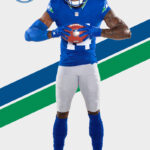The American military uniform during World War II was a study in practicality and adaptability, designed to equip soldiers for combat across diverse theaters of operation. This article delves into the key components of the WWII American uniform, examining variations used in both the European and Pacific theaters.
European Theater of Operations
In the European Theater, American soldiers faced a variety of weather conditions, demanding uniforms that offered protection from the cold and wet European climate. Key uniform items included:
Field Jackets
Two primary field jacket designs were utilized: the M-1941 and the M-1943. The M-1943 field jacket (pictured below) became the standard issue, phasing out the earlier M-1941. Constructed from darker olive drab cotton-poplin, this jacket was a significant improvement. It featured a single-breasted design with concealed buttons, incorporating two internal pockets for added utility. A detachable hood and a cotton-poplin liner provided increased warmth and adaptability. An internal synching tie allowed for a more fitted silhouette, enhancing comfort and mobility. Critically, the M-1943 jacket offered improved wind and water resistance compared to its predecessor.
Alt text: Close-up of a WWII US Army M-1943 Field Jacket in olive drab cotton-poplin, showcasing hidden buttons and pocket details.
The earlier M-1941 field jacket, in a lighter olive drab cotton-poplin, was designed as a windbreaker. Lined with wool flannel, it offered some warmth. It featured a zipper closure, a roll collar, buttons, and slanted front pockets. Its looser cut and economical design made it a practical replacement for the service coat in field conditions.
Overcoats
For colder weather, the overcoat was essential. Constructed from a thick wool melton fabric, the overcoat provided substantial warmth due to its dense weave and soft surface. This heavy coat was crucial for soldiers enduring harsh European winters.
Service Shirts
The standard service shirt was a button-up style made from olive drab wool flannel. These shirts included two breast pockets and buttoned cuffs. The collar was designed to accommodate a necktie, reflecting the formal structure of the military even in field settings.
P1937 Trousers
P1937 trousers were the standard issue for both service and field wear. Made from olive drab wool serge, these trousers were durable and practical. They featured a button fly, were unlined, and included diagonal side pockets, a single rear pocket, belt loops, and internal suspender buttons. Notably, breeches were largely relegated to mounted cavalry units by this time.
M1943 Trousers
Introduced mid-war, M-1943 trousers were designed as an improvement for field conditions. Made from a darker shade of olive drab cotton poplin, they were unlined and featured adjustment tabs at the ankles and waist. This design allowed them to be worn over wool trousers in colder climates, adding a layer of versatility to the uniform system.
M1938 Leggings
M1938 Leggings were khaki or olive drab cotton canvas coverings worn in conjunction with field service shoes. These leggings laced up the side and were secured with hooks and eyelets, featuring an adjustable strap that went under the instep of the boot. Leggings provided ankle support and protection. However, with the introduction of combat boots in 1943, leggings became redundant and were phased out. Puttees, which were used in WWI due to trench warfare, were also no longer necessary in WWII’s more mobile conflicts.
Pacific Theater of Operations
In the Pacific Theater, the climate and combat environment differed significantly from Europe. The hot, humid conditions of the Pacific jungles and islands necessitated lighter, more breathable uniforms. Camouflage also saw its first significant use by US troops in WWII within the Pacific theater.
Camouflage Uniforms
Interestingly, despite common perception, US troops first utilized camouflage uniforms in WWII in the Pacific, not Europe (where German forces were already using camouflage). While not universally prevalent, camouflage uniforms in the Pacific were reversible. They featured a green color scheme for jungle environments and a tan scheme for beaches and drier terrain.
Jackets (Pacific)
Jackets for the Pacific theater were constructed from herringbone twill cotton. This olive drab fabric was chosen for its breathability and quick-drying properties, a significant advantage over wool in the humid climate. These jackets were unlined and featured a single-breasted design with five buttons, two flap-secured breast pockets, and a roll collar designed to be worn open at the neck for ventilation. While designated for jungle-desert combat, some herringbone twill jackets were issued to troops involved in the Normandy Invasion, treated for added protection against chemical agents, demonstrating the adaptability of uniform components.
Trousers (Pacific)
Trousers in the Pacific were also made from herringbone twill cotton in olive drab, mirroring the jacket material for the same reasons of breathability and quick drying. These trousers were unlined and featured a button fly, belt loops, and internal suspender buttons. A distinctive feature was the inclusion of large flap-secured cargo pockets on each side, providing ample storage for equipment in the field.
This overview highlights the key aspects of the WWII American uniform, showcasing its design for functionality and adaptation to diverse combat environments. The uniforms of WWII reflected the logistical and tactical demands of global warfare, equipping American soldiers for victory across the world.

